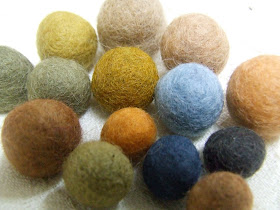
Wednesday, 31 March 2010
NATURAL DYEING WITH TEA LEAVES
Tea is probably one of the most readily available dyestuffs and one that we have used several times in the past.. Tea contains tannin, which stains and colours giving good lightfast properties. We used alum as a mordant on these raw silk shawls, using 10% of the fabrics weight to gauge the amount of alum required. For this experiment we used enough tea leaves to match the weight of the fabric. Different quantities of tea can be used to adjust the strength of the dyebath. Pictured below are our results from a recent dyebath.


Monday, 29 March 2010
NATURAL DYEING WITH RED ONIONS
Our most recent experiment with natural dyes was with red onion skins. We know that onion skins produce a strong yellow, but wondered what the results would be with red onions.
I assume that these onions contain a pigment called anthocyanin which can also be found in red cabbage and beetroot. This assumption was proved correct with the resulting colour. The blue colour of anthocyanin mixed with the yellow pigment that also exists in regular onions provides a beautiful kharki. We have yet to try regular onions, but suspect that they will form the base of our next experiment.
The images below show both the boiling stage and finished results on a raw silk shawl.

I assume that these onions contain a pigment called anthocyanin which can also be found in red cabbage and beetroot. This assumption was proved correct with the resulting colour. The blue colour of anthocyanin mixed with the yellow pigment that also exists in regular onions provides a beautiful kharki. We have yet to try regular onions, but suspect that they will form the base of our next experiment.
The images below show both the boiling stage and finished results on a raw silk shawl.

Wednesday, 24 March 2010
Thread Dyeing Advantages
This year saw Sorazora's introduction to thread dyeing. Previously we had been fabric dyeing with natural dyes, which lead to a small percentage of damaged material due to uneven colouring. Thread dyeing significantly reduces this kind of damage and produces a more even shade throughout the fabric after hand weaving. One other advantage is the effect gained through weaving different coloured threads within a single fabric. Our hemp cotton shawls, pictured below, illustrate the beauty of the various dyestuffs used.
Wednesday, 10 March 2010
OPEN FOR 2010
Sorazora website is now open for business after my return from Nepal. The production for our 2010 collection is now underway and the new designs will be slowly uploaded from April. This year sees more use of nettle fibre as well as the usual natural fibres.
Felt has made a reappearance after our experimenting with natural dyes proved quite successful. The felting process requires alkaline soaps, which react strongly with natural dyes, and our attempts have showed signs of colour remaining after this process. For this year we have dyed felt after it has been processed, but our experiments have proved that natural dyed felt is a possibility with which we will explore more next year. All of the felt factories in Nepal use chemical dyes as natural dyes are prohibitively expensive and enjoy little demand from customers.
Felt has made a reappearance after our experimenting with natural dyes proved quite successful. The felting process requires alkaline soaps, which react strongly with natural dyes, and our attempts have showed signs of colour remaining after this process. For this year we have dyed felt after it has been processed, but our experiments have proved that natural dyed felt is a possibility with which we will explore more next year. All of the felt factories in Nepal use chemical dyes as natural dyes are prohibitively expensive and enjoy little demand from customers.
The above photo shows small felt balls in the colours we will be using this year. We are happy that we can now use felt again as we would like to support all the effort being made by the ladies at the factory we use. We would also like to thank Kiran-ji for all his help and support with natural dyes. His experience is invaluable and we share the same beliefs and working ethos.
Please check our online store as the products of many peoples' collective hard work will be uploaded through the course of April.





